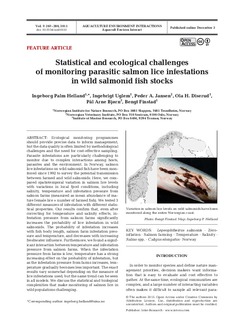Statistical and ecological challenges of monitoring parasitic salmon lice infestations in wild salmonid fish stocks
Helland, Ingeborg Palm; Uglem, Ingebrigt; Jansen, Peder A; Diserud, Ola Håvard; Bjørn, Pål Arne; Finstad, Bengt
Peer reviewed, Journal article
Permanent lenke
http://hdl.handle.net/11250/2367261Utgivelsesdato
2015Metadata
Vis full innførselSamlinger
- Publikasjoner fra CRIStin - NINA [2364]
- Scientific publications [1392]
Sammendrag
Ecological monitoring programmes
should provide precise data to inform management,
but the data quality is often limited by methodological
challenges and the need for cost-effective sampling.
Parasite infestations are particularly challenging to
monitor due to complex interactions among hosts,
parasites and the environment. In Norway, salmon
lice infestations on wild salmonid fish have been monitored
since 1992 to survey the potential transmission
between farmed and wild salmonids. Here, we compared
spatiotemporal variation in salmon lice levels
with variations in local fjord conditions, including
salinity, temperature and infestation pressure from
salmon farms (measured as mean abundance of mature
female lice × number of farmed fish). We tested 3
different measures of infestation with different statistical
properties. Our results confirm that, even after
correcting for temperature and salinity effects, in -
festation pressure from salmon farms significantly
increases the probability of lice infestation in wild
salmonids. The probability of infestation increases
with fish body length, salmon farm infestation pressure
and tem perature, and decreases with increasing
freshwater influence. Furthermore, we found a significant
interaction between temperature and infestation
pressure from salmon farms. When the infestation
pressure from farms is low, temperature has a strong
increasing effect on the probability of infestation, but
as the infestation pressure from farms increases, temperature
gradually becomes less important. The exact
results vary somewhat depending on the measure of
lice infestations used, but the same trend can be seen
in all models. We discuss the statistical and biological
complexities that make monitoring of salmon lice in
wild populations challenging.

